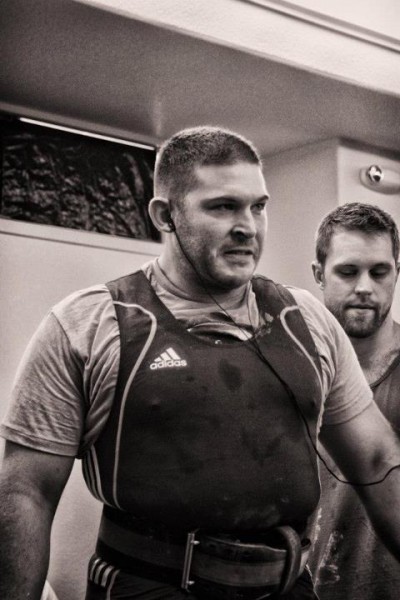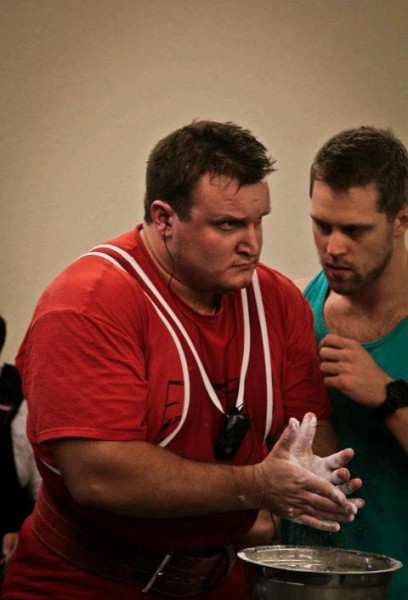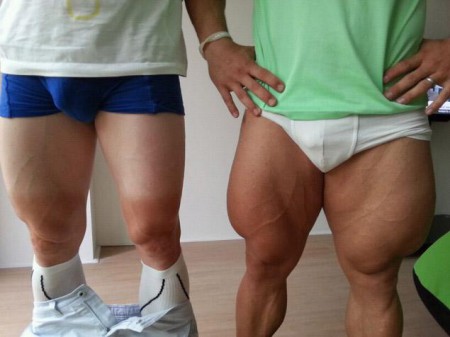Arin Canecchio returned to the “national scene” (his last national meet was in 2010) in the 220 class. He’s had a few things get in the way of training including surgery to remove a cyst on his ass earlier this year and recently a shoulder issue (his acromioclavicular and sternoclavicular joint — I think it’s due to elbow flare on the bench). The shoulder would give him some issues on the platform during bench. He’s looking forward to the opportunity to consistently train without set backs.
We opened with an easy 518 on the squat (AC has routinely hit 10 or 15 pounds more than this for doubles). AC is a pretty emotional lifter and induces huge spikes of adrenaline. Sometimes I wonder if he’s getting too amped for his early attempts and I wonder if it would be better to save them for later attempts (especially over a long meet). In any case, he destroyed the opener and we moved up to an equally successful lift of 540. I called for our plan of 562 for the third; I had been telling AC for a couple of months that I wanted him to hit this weight. He got amped, un-racked it, took it for a ride, and had consistent speed on the ascent for three white lights followed by a victory scream. He’s fun to coach.
AC took an easy bench opener of 364, but the aforementioned shoulder issue (left side) made 386 difficult. He got it, but the bar wasn’t even on the way up and it was a grinding rep. I gave him a 2.5kg jump to 392, which would have been a meet PR, but it was too heavy with the shoulder tweak. We’ll get this issue taken care of.
We opened deadlift with an easy 502 as the last warm-up. Then, as he was about to do 546 for his second, the judge at the chalk stand told him that his socks weren’t high enough. Mind you, this was after they were not only verified at the equipment check-in, but she allowed him to do his first attempt with them on. AC was livid when the clock ran down as he was trying to change socks. I did some quick thinking and put in a lighter third attempt than we planned (you can change 3rd deadlifts twice) and then took him in the back, had help quickly loading 545 in the warm-up room, and had him hit it. It wasn’t as fast as I would have liked because he wasn’t able to get psyched like he would have on the competition platform, so I stayed with the 573 I called for.
AC gripped it, ripped it, and had a pretty simple white lighted third attempt at 573. There was some weight left on the bar; he had at least 584 and probably 590, but I don’t regret the decision given the circumstances. It was a pretty good meet for AC, and consistent training will let his numbers push on up. I’d like to see him squat 600, bench over 400, and deadlift over 600. I think he could hit those numbers by next spring. The bench is there, we just have to address the shoulder issue.
Norman Palencia was in the same 220 session as AC. I think this was his second meet and first national meet. I’ve known him for a few years and he has really improved as a lifter since he’s gotten out of the military (i.e. he’s been able to gain some weight). Norman’s squat technique is pretty good, and he hit simple attempts at 419 and and 441. He missed the third at 463; if I remember correctly he had a shift forward and lost his hip engagement (when force production shifts to the quads and leaves the posterior chain, there is less musculature helping to move the weight).
Norman took an easy opener at 298 and followed it with a successful second at 314. The 5kg jump to 325 proved to be too heavy that day and he finished 2/3. We opened with a low 474 as a last warm-up on the deadlift. Throughout the day, Norman wasn’t really emotionally aggressive like AC, which is fine, but his energy levels seemed to be dwindling. He had a crack at 513, but the miss was over pretty quickly. It’s a weight that he’s pulled for multiple reps in the past, and just the intermediate jump to around 540 or so, but he was, in his words, exhausted. Meets, especially national meets, are a bit different than training. Factor in that he dropped a little bit of weight and traveled by airplane, and it wreaks havoc on a newer lifter. I wish we could have hit some better numbers with Norman because powerlifting won’t be his primary focus due to a future job, but he will still improve if he chooses to dabble in the future. As a side note, Norman is one of Brent’s favorite people now.
Mike Battaglino competed in the 275 class and was coming into this meet off a recent PT test (which always require dropping weight and not lifting as much, though I wonder if he can do it without disrupting the training schedule next time). We opened the squat with an easy 529. Mike was red lighted on his last two attempts at the Arnold so he’s modified his squat so that it’s without question. He made good on a jump to 557, and then he requested 573 on the third, which was a bit lower than the high-end plan of 579. He came out, got rowdy, took it for a ride, and ground through a pretty simple squat. There was weight left on the bar, but it probably felt good to hit a third attempt knowing he had more in him (it tied a meet PR).
Mike’s bench has really improved lately, but a few weeks ago he tweaked his distal biceps un-racking a bench without a hand-off (do not do this). His warm-ups were fast and felt good, yet his bottom position was very unstable on his opener of 325. What happened is the bar went down, then settled quickly on his chest which made it bob up and down, then finally stopped while he was relaxed. Since he wasn’t tight, and the pause was so long due to the movement, he had a harder time with the attempt. This same position occurred on the second attempt and his injured side trailed during the miss. We attempted the same weight of 342 on the third attempt, and I gave him the cue to “drive right” to over-emphasize the right arm’s drive. It turned out that the soft bottom position was too much to overcome, though it was slightly better, on this third rep. Mike was bummed but there wasn’t anything we could have done about the injury.
Mike opened on deadlift with an easy 562 as a last warm-up, then his a slightly slower 611 on the second. We decide to go for 639, which is well within his grasp. On another note, Mike is battling with Randy Cairns for a fifth place (i.e. medal spot). As long as he hits this third attempt, he’ll beat him. It’s not that we don’t like Randy — he’s a good guy — but he has beaten Mike twice and it’s a friendly rivalry. Randy missed his third deadlift, so we could have changed Mike’s third attempt lower to make an easier pull for 5th, but we weren’t gunning for 5th. We were more trying to get a solid pull on the third since he missed his third deadlift at the Arnold.
Mike approached 639, gripped it, and then started the pull. He’s fast off the floor, but due to his short torso, it always slows right around the knees. We knew it’d be a battle, but the bar was moving well up his baby powdered thighs…until the left side of the bar — the side I’m standing on — gets caught on the band of his singlet. He’s wearing a weightlifting singlet, and it pulls the band inside out so that the rubber coating is now in contact with the bar. This causes the left side to fully stop, and if you watch the video, the right side actually continues moving up while the left side is stationary. I’m fully convinced that if his singlet was pulled up into his testicles, the bar would have slid up his thighs no big deal. Mike missed this third deadlift, and it left a sour taste in our mouths. You hate to see a lifter go through something like this, especially when it’s one of your best friends.
It turned out that Randy and Mike totaled exactly the same. And they weighed exactly the same (the lighter body weight will win when totals are equal) at 124kg. Since Mike had the chance to change his attempt after Randy’s third (and make a change to beat him whereas Randy couldn’t make a change), the decision was awarded to Randy. Mike was given a “participation” medal, which only pissed him off.
Mike is good powerlifter. He has made consistent progress in everything since I met him. He is meticulous with his training, makes good programmatic changes, is good at planning attempts for himself and others, and will be a very good coach some day (he is one now). Whenever his next meet is, he’ll squat at least 579, bench at least 353, and deadlift at least 644. It’s just a bummer to have this one meet swing on the completion of one lift, especially when it was due to an equipment issue. He’ll be back.
Chris Riley was looking to improve on all of his solid numbers at the Arnold in a heavily stacked super heavyweight class. Raw nationals gets more competitive every year because the first place winner makes the world. Brad Gillingham, one of the most legendary super heavyweight powerlifters of all time (he has pulled over 800 in over 80 competitions) didn’t even place first!
We opened with a no big deal 617 squat, then moved to the planned 644 on the second. He got it, but not without struggle. I saw him shift slightly forward and lose the hamstring/hip engagement that I’ve talked about prior in this meet write up series. Had he thought “push butt” up, then I think he could have kept the mechanics and had more musculature involved to have an easier rep. I asked Chris if he wanted me to cue that, and he said that he could correct it. We originally wanted to call for 666, a 2.5kg PR over his 661 at the Arnold, but since it looked slow, I called for 661 to tie it. After talking with him, I might have changed the third to 666, but you can’t change 3rd attempt squats.
Well, the same thing occurred on the ascent of the third squat, and Chris got hung up in the middle of the rep and missed it because of a lack of hip involvement. I think that this is due to Chris getting in the habit of getting “into his knees” on his heavy squats, so we’re going to make a point of making sure he gets and keeps tension on his posterior chain. I might modify the actual programming to, so we’ll see what happens.
Chris bench opener was 364. The particular guy giving the hand off was different than the first flight (Mike’s flight, he had done it all weekend), and he unfortunately wasn’t very good at it. When he gave Chris the bar on the opener, he brought it way out over his chest. Chris got the rep, but he had to pull the bar back into the right position, wasting time, and throwing him a bit off mentally. I called for the planned 386 and Chris and I both asked the guy to not bring the bar so far out. On the second attempt, the back spotter just lifted the bar straight up, and Chris had to pull the bar down into position while under a load, which is the same position that Mike injured his biceps in a few weeks ago. This pissed Chris off again, made him use a bunch of energy stabilizing the bar, and wasted time. He ended up missing the rep. I called for the same weight (we had planned to go up to 402 with Chris’ close grip style) and asked the judges if we could get a different person to hand-off. The loaders all did a great job, but this one particular guy probably wasn’t experienced in hand-offs and it had an effect on Chris’ performance. They brought the original back spotter out, and he gave Chris a good lift-off and he made the 385.
We opened with a frighteningly fast 611 on the deadlift opener (last warm-up); the plates bobbed up and down at the lockout. Then we took 666 as the intermediate jump for the second attempt. Chris had been wanting to try and hit as high as 727 coming into this meet, but in truth I had always planned on calling 711 or 717 (him reading this will probably be the firs time he hears this). The 666 was slightly slower than I would have liked, and Mike and I agreed on 711 (though I almost pushed for 717). I settled on the former because I would rather him meet PR on the deadlift since he missed his third squat and only matched his meet PR bench.
Chris stepped into the room as they loaded his bar, adrenaline surging. The meet was located within a church, and I hope that they didn’t mind that we were summoning the demons. I pulled his headphones out and said some choice words and pushed him to the bar as he grunted loudly, nips sticking out of his singlet. He gripped the bar with his double overhand hook grip, took a breath, set his back, and started the pull. Chris has beautiful technique, even with heavier weights. His long torso, giant back, long arms, and short femurs make it possible. The bar never strays away from his legs, and he has long ago learned to make the lockout smooth. He knows how to battle. If I call the right weight, he’s gonna lock it out. And he ground through that rep with the crowd yelling, my throat straining for the last time that weekend. And then he finally locked 711, a full convenience store, out for three white lights. This was particularly satisfying for me as a coach and a really good cap to the long weekend. Chris screamed to the crowd, I screamed and jumped behind him, and we tackled each other in celebration. I was still slapping the wall when we walked down the hall and the old men who were running the church’s food services said, “Well, I suppose you got it. Congratulations.”
I joke around that I hate powerlifting when the meets are over, but I don’t really hate it. In the next post I’ll talk briefly on coaching and the lessons learned over the course of this meet. I felt that I owed it to the lifters to recap their experiences. They all chose to buck up and compete at a national event when so many people shy away from competition. They all did the best they could with the circumstances presented to them, and that counts for something. Through victory or defeat, and their were both this past weekend, competition is something that defines the soul.
It is not the critic who counts, not the man who points out how the strong man stumbles, or where the doer of deeds could have done them better. The credit belongs to the man who is actually in the arena…who strives…who spends himself…and who at the worst, if he fails, at least he fails while daring, so that his place shall never be with those cold and timid souls who know neither victory nor defeat.
–Teddy Roosevelt







